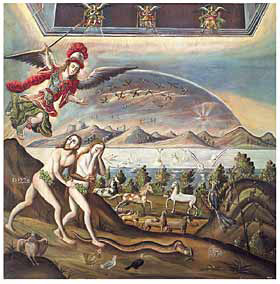 |
 |
 |
 Vallarta Living | Art Talk | April 2006 Vallarta Living | Art Talk | April 2006  
U.S. Takes Over Role of Returning Old Painting Stolen from Mexico
 Anna Cearley - Union-Tribune Anna Cearley - Union-Tribune


| | The painting "Expulsion From the Garden of Eden," by an unknown artist, was stolen in the tiny community of San Juan Tepemazalco in Hidalgo state. (San Diego Museum of Art) |
More than a year after a stolen 18th-century Mexican painting was found to be in the possession of the San Diego Museum of Art, the U.S. government is taking steps to return it to Mexican authorities.

Immigration and Customs Enforcement took temporary custody of the painting last month while it awaits word from Mexico as to who will receive it. Meanwhile, the painting remains at the local museum for safekeeping, but is not on public view.

The painting's return has been delayed by an investigation, legal issues and the challenge of coordinating the return through various government channels.

Jerry Coughlan, attorney for the museum, said the museum wanted to return the painting, but officials received conflicting information over whether the painting should be given to Mexican government anthropological groups or to the local municipality from where it was stolen.

“We never could get a clear answer as to who was the rightful owner,” he said. “So we said to the (United States) government, you take it and deal with it.”

U.S. officials plan on returning the painting to the Mexican Consulate in San Diego once the ownership question is answered – perhaps within a month.

Establishing who is the appropriate owner is necessary to prevent lawsuits.

The painting, “Expulsion From the Garden of Eden,” by an unknown artist, was stolen in 2000 from a Mexican church in the tiny community of San Juan Tepemazalco, in the interior state of Hidalgo.

The San Diego museum acquired the painting that same year from a private collector in Mexico. The painting's actual origins came to light several years later.

In 2004, U.S. authorities opened an investigation into how the museum acquired the painting, and the museum vowed to return the painting to its rightful owners as soon as possible.

No indictments have been issued in the case, though it remains open, said Lauren Mack, ICE spokeswoman.

Mack said the agency technically placed a “constructive seizure” on the painting Feb. 8 and the agency asked the museum to keep it for the time being.

“We don't have an appropriate place to hold it,” she said. “They can take care of it properly and keep it safe.”

Derrick Cartwright, the museum's director, said in an e-mailed response to questions that the painting is in a climate-controlled, highly secure storage vault, away from public viewing. He said the museum never heard back from Mexican authorities regarding its offer to restore the painting.

Before the artwork ended up in the San Diego museum, it was linked to Rodrigo Rivero Lake, a well-known art expert and dealer in Mexico. It's unclear whether Rivero is under investigation in Mexico.

Museum officials said in 2004 that they intended to file a claim against the Mexican vendor who sold them the painting.

Cartwright said this week that the museum received a full reimbursement from the vendor, whom he did not name, that had been “offered voluntarily and graciously.” He didn't say how much that was.

The painting, acquired when the museum was headed by Don Bacigalupi, is estimated to be worth between $10,000 and $50,000.

The controversy over the painting exploded shortly after Cartwright replaced Bacigalupi, who had become director of the Toledo Museum of Art in Ohio.

Museum officials reacted by tightening their policies to ensure that artwork the museum obtains hasn't been stolen or smuggled into the country.

Luis Cabrera Cuarón, the Mexican consul general in San Diego, said the Mexican government is preparing to accept the painting but would not provide details.

“The procedures are taking their course,” he said.

Cabrera declined to comment on why the process has taken this long.

“For some people it's long, but it's relative,” he said, adding that international issues such as this one can be very complicated, but that the Mexican government is eager to have the painting returned.

“The government of Mexico is interested in this case, as in other cases to recuperate works of art that according to our laws are property of the nation,” he said.

Anna Cearley: (619) 542-4595; anna.cearley@uniontrib.com | 
 | |
 |



